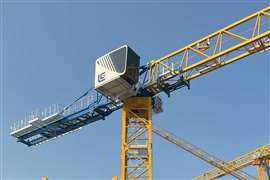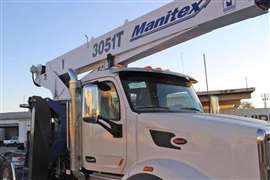Polish rental companies talk about their market
22 July 2009

Poland shares many economic woes with its European neighbours but it is also in a unique position with record EU investment and GDP growth. The crane rental sector is also in conflicting circumstances. iC reports.
The Polish industry is at a critical point with aggressive competition forcing rates dangerously low. This situation is worsened by the exchange rate of the Polish Zloty against the Euro. It has left crane owners facing further financial strain and it is all in the face of an economic downturn.
On the other hand, Poland was the only country in Europe to see positive growth in the first quarter of 2009. Figures from Eurostat show gross domestic product (GDP) grew by 1.8% in the first quarter of 2009. The prospects for the rest of the year are also positive compared to other EU nations, with growth forecast at up to 1.4%.
Poland has also received the most central EU funding of all the Eastern European states. The hive of activity leading up to the football 2012 European Championships, taking place in Poland, provides additional optimism. It includes 500 km of new roads, 800 km of railway and four new stadiums. By the end of 2013 the Polish government will have invested €65 billion in infrastructure, according to the country's new Kobelco dealer IPIS.
The need to hit emission agreements has resulted in a wave of new wind turbine parks and power plants, as well as government plans to build two nuclear power plants. They will go some way to provide the country's need for more power generation, "before the lights go out," as Jolanata Mirkowicz, Sarens Polska managing director puts it.
On hold
Like everywhere else, the world recession has affected Poland with new construction projects being put on hold indefinitely.
Stanisław Maszczyński is general manager of Mastal, the Polish dealer for Terex-Demag. "2008 was the best year here in Poland but, by the beginning of the year, we knew that something was happening in the west - we did not believe it - but the wave came in February."
This, Maszczyński adds, has resulted in shortened lead times and reduced demand - a familiar story around the world. Crane users are waiting to see what the future will bring before placing orders. "Last year we noticed inquiries for bigger cranes, 100 tonnes-plus, but this year the unpleasant economic atmosphere in the West and the increasing exchange rate of the Polish Zloty against the Euro caused a substantial reduction of demand."
Maszczyński believes there are about 30 crane owning companies in Poland with 10 or more units. Some of those operate machines manufactured in the country, which, Maszczyński says, need to be replaced. There is no longer, however, any crane production in Poland and those models still working represent the last throes of the country's big four truck crane manufacturers. The largest being Bumar Labedy, which also produced Poland's biggest models at 50 tonnes capacity. It was in its element when Poland was the Peoples Republic of Poland, a satellite state of the former Soviet Union.
Wind power
One of Mastal's biggest customers is Gastel, in Warsaw, which operates a lifting and heavy transport division called Herkules. It offers a range of wheeled mobile cranes manufactured by Terex Demag, Grove, Liebherr and Krupp, up to 500 tonnes capacity, plus crawler cranes from Terex Demag. Its latest crawler crane acquisitions were a CC 2500-1 and CC 2800-1.
The 100 to 200 tonne capacity all terrains get highest utilisation, according to Gastel president Tomasz Kwieciński, for the assembly of tower cranes, steel and road construction and industrial applications.
Kwieciński explains, however, that one of the biggest growth areas is wind turbine erection and maintenance. By the end of 2007, there was 300 MW of wind generated energy in Poland, and by 2020 that will have soared to 10,000 MW, he adds. Western European turbine producers, including Vestas, are also setting up facilities in the country.
Gastel plans to invest for the future but is experiencing the same problem found across the crane rental sector; that of extreme competition and the difficulty in accessing credit. One area of interest is 1,000 tonne and above mobile telescopic cranes, the likes of which are increasingly finding application in the country.
Pioneering
Maciek Goździk, co-owner of Szczecin-based rental company Kran-Waryło, says another trend brought about by the economic climate is late payment by customers.
Kran-Waryło was set up by Goździk's parents-in-law Leopold and Irena Waryło and is a pioneer of the Polish rental sector. It first bought a fleet of four tonne capacity models when the country was part of the Eastern Bloc and such entrepreneurship was frowned upon.
This problematic arrangement was brought to an end when the company was officially registered as a crane rental business in 1989 in Szczecin, following the fall of Communism. At this point the company invested in 50 tonne truck cranes from former Polish military equipment manufacturer Bumar Labedy and in 1993 bought its first western manufactured crane, a 160 tonne Liebherr - a massive and risky investment at the time. It was thanks to a buyback commitment from Liebherr that persuaded the leasing company involved to provide the credit. "This all came at a good time because of the rise of the mobile phone networks and the need for such cranes," says Goździk.
Now the company boasts a fleet of 45 mobile cranes up to 750 tonnes capacity, mainly Liebherrs. They are used for the construction of wind turbines, power plants and bridges, as well as junctions and intersections on new roads. The latter being a major source of work for the next 20 years, Goździk added. But its attempts to buy new cranes are also being thwarted by the lack of credit. The company had planned to buy a 250 tonne capacity crane in February 2009 but the order had to be postponed.
Small rental companies are also causing problems for large rental fleets, explains Goździk. In many cases operators own one machine which has been fully paid for. They are able to force low rates, which leaves companies with new cranes and large repayment deals struggling in the economic climate.
Falling
In some cases rates are down 50%. In one recent example, according to Goździk, a long-term rental deal for a Terex Demag CC 2500 was haggled down to €150 (US$210) an hour. Last year the same machine would have fetched €400 to 500 an hour ($561 to 701). "There's not that many people with the same cranes so there is no comparison and it is difficult to set prices."
Another trend, says Goździk, is for customers to rent the cranes for the shortest possible time. "In the West there is a bigger investment in cranes and they are staying in one place for longer periods". He adds that protectionism in Germany also means that Poland-based cranes are not considered for projects in the country, even though many of them were manufactured there.
To add insult to injury, Irena Waryło, Kran-Waryło co-owner, says Western European rental rates are higher, yet crane purchase prices are generally the same as in Poland. Another benefit in the west, she says, is that those who rent cranes are better disciplined when it comes to payment. "Polish companies compete with each other and force down prices. Prices are a big problem. At the beginning of the 1990s it was a very good situation. There were plenty of jobs and no big competition. In the ‘90s there was the problem of obtaining cranes, now there is the problem of financing."
Full market
Sarens Polska managing director Jolanta Mirkowicz says there are now too many cranes on the market because many smaller companies invested in the popular 200 tonne capacity range models during the boom years. This optimism may lead to their downfall in current conditions. "It is easy for us to receive a leasing contract because we are reliable company. This is a big problem for little crane companies," says Mirkowicz.
At least Sarens Polska is able to send unused machines to other markets around the world, using the Sarens network. "If I have a 500 tonne crane that has no job in Poland I can send it to Algeria, for example, so I do have jobs." However, any assumption that Sarens Polska can fall back financially on Sarens in Belgium, is wrong, says Mirkowicz, as Sarens Polska is an independent company.
A problem shared by all rental companies is the exchange rate of the Zloty against the Euro. As Mirkowicz explains, 2008 rental rates, of, for example 1,200 to 1,400 Zloty per hour for a 500 tonne mobile crane, went hand-in-hand with the favourable exchange rate of 3.5 Zloty to the Euro. Now, the economic crisis has brought the average rental rate down by 20 to 30%, or about 840 Zloty per hour for the same crane. At the same time, the value of the Polish currency has risen to 4.5 Zloty to the Euro. The combination has effectively halved rental rates. For this reason membership of the Euro "cannot come soon enough," says Maciek Goździk.
One company that will eventually benefit from this situation is Żuraw Grohmann, headquartered in Gdansk. It claims to be the biggest crane rental company in Poland with 10 depots, offering mobile and tower cranes, along with heavy transport. According to the company, Poland is on the brink of a big consolidation phase that will first happen in the tower crane sector. The recession, it says, will result in many small companies merging or selling their cranes which larger companies will buy.
Ad-hoc towers
There are four to five leaders in the tower crane sector but the rest of the market belongs to small companies that have one or two cranes. It is an ad-hoc rental situation, often without contracts, explains Żuraw Grohmann. EFH, based in Warsaw, is the biggest, followed by Streich, the division of a Germany-based company. Third is Bauhaus and fourth is Żuraw Grohmann, which is also affiliated to Germany-based Grohmann. "But we have a crisis and it is possible that many small firms will collapse."
Wojciech Fait, Żuraw Grohmann marketing manager, says just 30% of the tower crane fleet has work. As far as mobile cranes are concerned, "There is work but the questions is, are they profitable?"
The company's president, Tadeusz Koterwa, says the problem lies in the lack of any standard rates across the rental industry. "Everyone is doing what they want and, once prices have gone down, it will be difficult to get them back up again."
Three years ago there were up to three 500 tonne capacity mobile cranes in Poland. That has now increased to about 17, which means the market is full, says Koterwa. He adds that there is also no professional association to lobby or provide a voice for the industry. Bearing all this in mind, Koterwa believes the situation will change when rental companies are forced to sell some of their machines, reducing the saturation of the market and bringing down rental rates.
Jolanta Mirkowicz at Sarens Polska is also optimistic about the future. She forecasts that the number of power plants will double in the next 10 years to prevent the risk of an electricity shortage. Two of these will be brown coal powered plants.
Mariusz Sudoł, Sarens Polska's main engineer adds that the country will be making modifications to existing power plants to meet emission targets. In anticipation the company is designing specialized spreaders and a sling system for its crawler cranes to install pipes and clean domes.
The company is also putting up three to four wind turbines a week, and this will increase. Many of them are low capacity units bought by farmers to place on their land. One of the most popular turbines in the farming community is the 0.5 MW Enercon E40. They tend not to exceed 1 MW and are generally eight to 10 years old.



